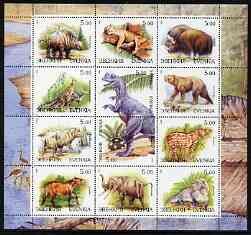Mini Sheet: Movies (Cinderellas 2000)
Movies (Cinderellas 2000)
01 January (Cinderellas ) within release Russia : Evenkia goes into circulation Mini Sheet Movies face value 12*5 Russian ruble
| Mini Sheet Movies in catalogues | |
|---|---|
| Colnect codes: | Col: RU-EV 2000-04 |
Mini Sheet is square format.
This item was illegally produced without the authorization of the postal administration inscribed on the stamps. They have no postal validity.Also in the issue Russia : Evenkia:
- Stamp - Actress face value 2.50;
- Stamp - Actress face value 2.50;
- Stamp - Actress face value 2.50;
- Stamp - Actress face value 2.50;
- Stamp - Actress face value 2.50;
- Stamp - Actress face value 2.50;
- Mini Sheet - Actresses face value 6*2.50;
- Mini Sheet - Basset Hound face value 45;
- Stamp - Basset Hound face value 1;
- Stamp - Basset Hound face value 2;
- Stamp - Basset Hound face value 3;
- Stamp - Basset Hound face value 4;
- Stamp - Basset Hound face value 5;
- Stamp - Basset Hound face value 6;
- Stamp - Basset Hound face value 7;
- Stamp - Basset Hound face value 8;
- Stamp - Basset Hound face value 9;
- Mini Sheet - Staffordshire Bull Terrier face value 45;
- Stamp - Staffordshire Bull Terrier face value 1;
- Stamp - Staffordshire Bull Terrier face value 2;
- Stamp - Staffordshire Bull Terrier face value 3;
- Stamp - Staffordshire Bull Terrier face value 4;
- Stamp - Staffordshire Bull Terrier face value 5;
- Stamp - Staffordshire Bull Terrier face value 6;
- Stamp - Staffordshire Bull Terrier face value 7;
- Stamp - Staffordshire Bull Terrier face value 8;
- Stamp - Staffordshire Bull Terrier face value 9;
- Mini Sheet - Movies face value 12*5;
- Se-tenant - Owls face value 4*10;
- Se-tenant - Owls face value 6*5;
- Se-tenant - Owls face value 6*7;
- Mini Sheet - Owls face value 6*5;
- Se-tenant - Owls face value 4*10;
- Mini Sheet - Owls face value 6*7;
|
Data entry completed
53%
|
|
|---|---|
| Mini Sheet Movies in digits | |
| Country: | Cinderellas |
| Date: | 2000-01-01 |
| Print: | Offset lithography |
| Emission: | Незаконный |
| Format: | Mini Sheet |
| Face Value: | 12*5 Russian ruble |
Mini Sheet Movies it reflects the thematic directions:
Animals are multicellular, eukaryotic organisms of the kingdom Animalia (also called Metazoa). All animals are motile, meaning they can move spontaneously and independently, at some point in their lives. Their body plan eventually becomes fixed as they develop, although some undergo a process of metamorphosis later on in their lives. All animals are heterotrophs: they must ingest other organisms or their products for sustenance.
Dinosaurs are a diverse group of reptiles of the clade Dinosauria. They first appeared during the Triassic period, between 243 and 233.23 million years ago (mya), although the exact origin and timing of the evolution of dinosaurs is a subject of active research. They became the dominant terrestrial vertebrates after the Triassic–Jurassic extinction event 201.3 mya and their dominance continued throughout the Jurassic and Cretaceous periods. The fossil record shows that birds are feathered dinosaurs, having evolved from earlier theropods during the Late Jurassic epoch, and are the only dinosaur lineage known to have survived the Cretaceous–Paleogene extinction event approximately 66 mya. Dinosaurs can therefore be divided into avian dinosaurs—birds—and the extinct non-avian dinosaurs, which are all dinosaurs other than birds.
Mammals are any vertebrates within the class Mammalia (/məˈmeɪli.ə/ from Latin mamma "breast"), a clade of endothermic amniotes distinguished from reptiles (including birds) by the possession of a neocortex (a region of the brain), hair, three middle ear bones and mammary glands. All female mammals nurse their young with milk, secreted from the mammary glands. Mammals include the largest animals on the planet, the great whales. The basic body type is a terrestrial quadruped, but some mammals are adapted for life at sea, in the air, in trees, underground or on two legs. The largest group of mammals, the placentals, have a placenta, which enables the feeding of the fetus during gestation. Mammals range in size from the 30–40 mm (1.2–1.6 in) bumblebee bat to the 30-meter (98 ft) blue whale. With the exception of the five species of monotreme (egg-laying mammals), all modern mammals give birth to live young. Most mammals, including the six most species-rich orders, belong to the placental group. The largest orders are the rodents, bats and Soricomorpha (shrews and allies). The next three biggest orders, depending on the biological classification scheme used, are the Primates (apes and monkeys), the Cetartiodactyla (whales and even-toed ungulates), and the Carnivora (cats, dogs, seals, and allies).



